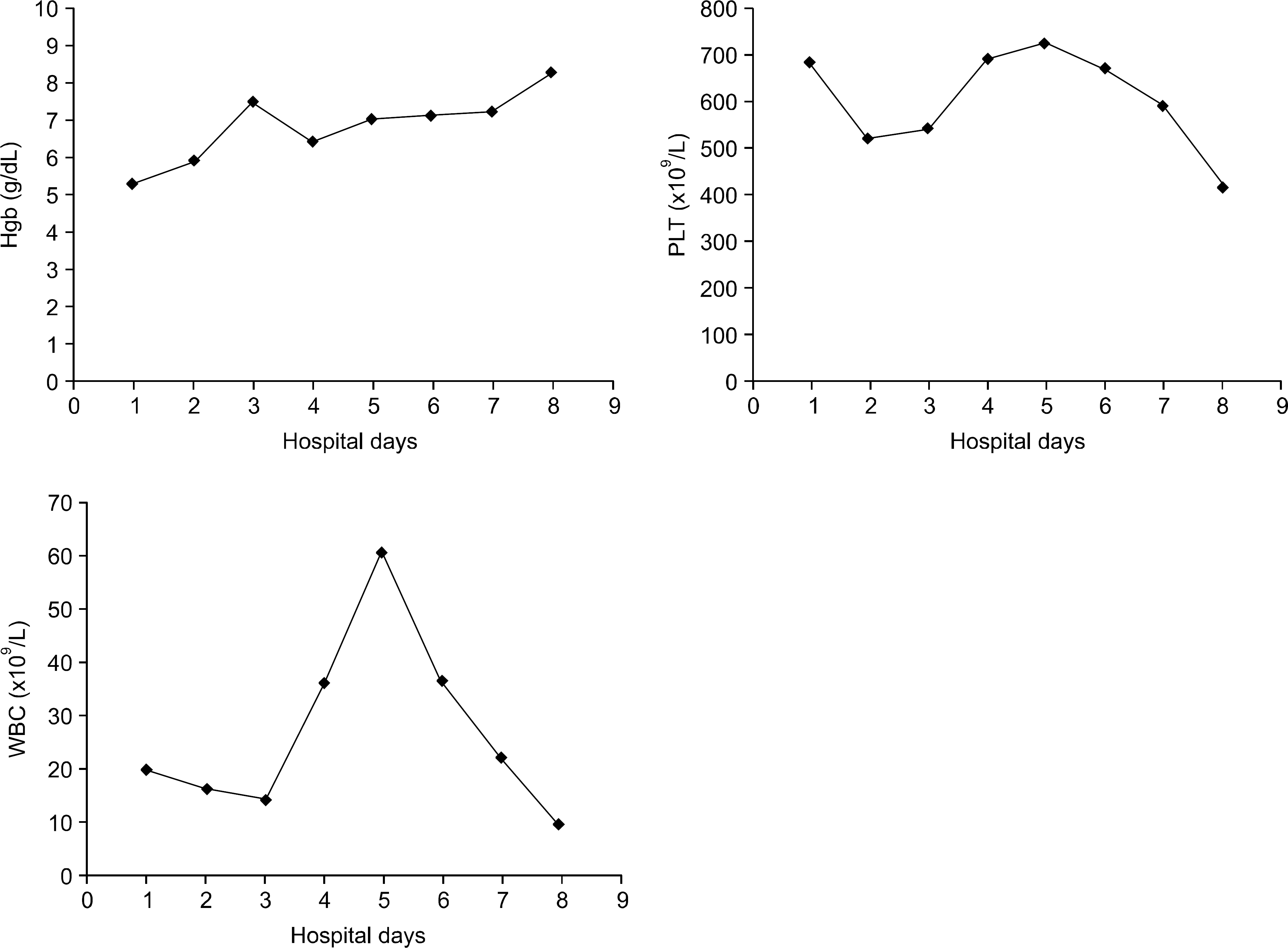Abstract
Autoimmune hemolytic anemia (AIHA) is characterized by the production of antibodies directed against red blood cells (RBCs). It is usually accompanied by normal white blood cell (WBC) and platelet counts. Severe leukocytosis and thrombocytosis in AIHA are rare. Here, we report a 3-year-old female child who showed AIHA by warm antibody testing with both leukocytosis and thrombocytosis. The patient was treated with oral steroids for 5 days. During treatment, the leukocytosis was noted on hospital day 3 and was up to 60.87×109/L. In addition, the thrombocytosis persisted at up to 725×109/L. After day 7, the WBC and platelet counts returned to the normal range. The clinical condition and vital signs improved. The patient was discharged on day 12. This case demonstrated that patients with primary AIHA, may also have leukocytosis and thrombocytosis.
REFERENCES
1). Oliveira MC., Oliveira BM., Murao M, et al. Clinical course of autoimmune hemolytic anemia: an observational study. J Pediatr (Rio J). 2006. 82:58–62.

3). Trivedi DH., Bussel JB. 21. Immunohematologic disorders. J Allergy Clin Immunol. 2003. 111:S669–76.

4). Daxbock F., Zedtwitz-Liebenstein K., Burgmann H., Graninger W. Severe hemolytic anemia and excessive leukocytosis masking mycoplasma pneumonia. Ann Hematol. 2001. 80:180–2.

5). Frenkel EP., Bick RL., Rutherford CJ. Anemia of malignancy. Hematol Oncol Clin North Am. 1996. 10:861–73.

6). Liang DC., Shih LY., Kuo MC, et al. The synergistic effect of thrombopoietinin erythropoiesis with erythropoietin and/or IL-3 and myelopoiesis with G-CSF or IL-3 from umbilical cord blood cells of full-term neonates. Pediatr Hematol Oncol. 2001. 18:383–91.
7). Liang DC., Shih LY., Chai IJ, et al. The synergistic effect of thrombopoietin in erythropoiesis with erythropoietin and/or IL-3 and myelopoiesis with G-CSF or IL-3 from umbilical cord blood cells of premature neonates. Pediatr Hematol Oncol. 2002. 19:399–405.

8). Broudy VC., Lin NL., Kaushansky K. Thrombopoietin (c-mpl ligand) acts synergistically with erythropoietin, stem cell factor, and interleukin-11 to enhance murine megakaryocyte colony growth and increases megakaryocyte ploidy in vitro. Blood. 1995. 85:1719–26.

9). Tsukada J., Misago M., Kikuchi M, et al. lnteractions between recombinant human erythropoietin and serum factor(s) on murine megakaryocyte colony formation. Blood. 1992. 80:37–45.
10). Ishibashi T., Koziol JA., Burstein SA. Human recombinant erythropoietin promotes differentiation of murine megakaryocytes in vitro. J Clin Invest. 1987. 79:286–9.

11). McDonald TP., Clift RE., Cottrell MB. Large, chronic doses of erythropoietin cause thrombocytopenia in mice. Blood. 1992. 80:352–8.
12). Bilic E., Bilic E. Amino acid sequence homology of thrombopoietin and erythropoietin may explain thrombocytosis in children with iron deficiency anemia. J Pediatr Hematol Oncol. 2003. 25:675–6.

13). Ramsfjell V., Borge OJ., Veiby OP, et al. Thrombopoietin, but not eryhropoietin, directly stimulates multilineage growth of primitive murine bone marrow progenitor cells in synergy with early acting cy-tokines: distinct interactions with the ligands for c-kit and FLT3. Blood. 1996. 88:4481–92.




 PDF
PDF ePub
ePub Citation
Citation Print
Print



 XML Download
XML Download